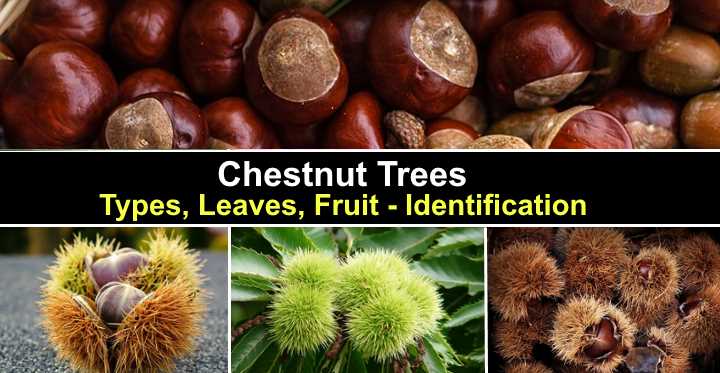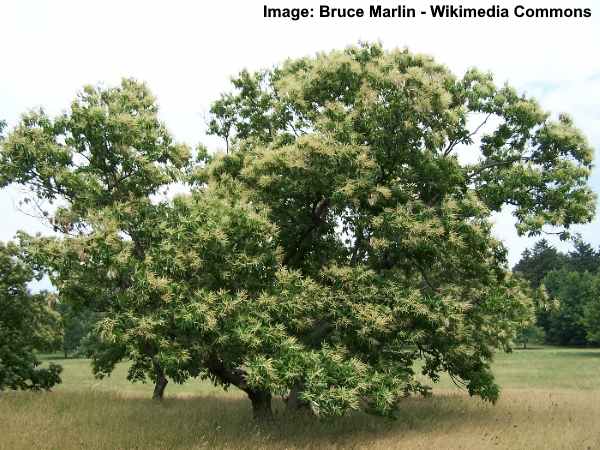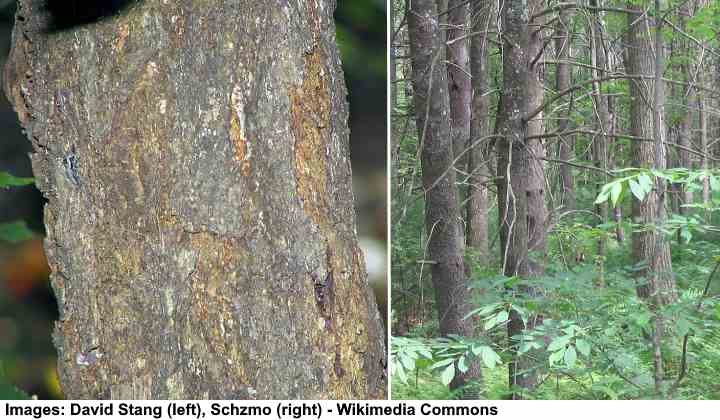Chestnut Trees: Types, Leaves, Fruit – American, European and More (Pictures) – Identification

Chestnut trees are large deciduous trees with large, pointed leaves, long, finger-like flower clusters, and brown edible nuts. Chestnuts are easily identifiable due to the spiky burs growing in clusters and containing the fruit—a brown-shelled nut encasing creamy-white flesh. Chestnut trees have a straight, broad trunk with deeply furrowed bark and a large spreading rounded canopy.
Chestnut trees are comparable to oak trees in terms of height, strength, and beauty. However, chestnut trees are fast-growing trees that mature at between 60 ft. and 100 ft. (18 – 30 m) tall. In open landscapes, chestnuts can be some of the largest and most impressive trees you will see.
Species of chestnut trees belong to the genus Castanea and the beech family Fagaceae. The flowering trees mostly grow in temperate regions of the world in USDA zones 5 to 7. Chestnut trees perform best in full sun and loamy, well-draining soil.
This article is a guide to identifying chestnut trees. Descriptions and pictures of chestnut leaves, flowers, and fruit will help identify these impressive deciduous trees. You will also find out the difference between horse chestnut trees and edible chestnuts.
Chestnut Tree Leaves

Chestnut tree leaves are long and narrow with serrated edges. Also pictured is immature fruit
Chestnut leaves are ovate or lanceolate-shaped with a smooth, leathery texture, coarsely toothed margins, and a bristly, tapering tip. Leaves on chestnut trees grow between 6” and 10” (15 – 25 cm) long and up to 4” (10 cm) wide. Leaves have a dull appearance and prominent veins.
Typically, all chestnut tree foliage turns a golden yellow color in the fall before the leaves drop.
Chestnut tree leaves appear in late spring before the flowers appear.
Chestnut Tree Flowers

Chestnut flowers
Chestnut flowers are creamy-white long catkins that blossom in summer and give off an intense, sweet fragrance. The long, dangling chestnut flowers grow 4” to 8” (10 – 20 cm) long. Both female and male parts are on the same flowers. However, chestnut pollination needs at least two trees to produce fruit.
Chestnut Tree Fruit

Chestnut fruit has pointed end
Fruit from a chestnut tree is an edible brown nut that forms in a sharp, spiny green bur or cupule that matures to yellowish-brown and splits open in two or four segments. Each spiked bur contains one to seven shiny brown nuts. Chestnut fruit is identifiable by its pointed end, a flattened side, and hard, shiny husk. The edible chestnut flesh is creamy-white with a spongy texture.
The taste of chestnuts is described as a sweet, nutty flavor reminiscent of popcorn. You can eat chestnut raw. But most people toast or roast chestnuts to bring their buttery flavor and improve their sweetness.
Chestnut Tree Bark
The bark on chestnut trees is light gray to dark brown, depending on the species. The bark on immature trees is smooth and a reddish-brown or green color. In time, the deep vertical fissures develop on the thick bark and create diamond patterns running longitudinally up the trunk.
Chestnut Blight

Chestnut blight
Chestnut blight (Cryphonectria parasitica) is a parasitic fungus that can infect trees, especially the American chestnut (Castanea dentata) species. Chestnut blight causes cankers to appear that reveal an orangey bark underneath. The fungus can affect nearby trees as the wind carries the spores. Chestnut blight can affect the whole tree, eventually killing it.
To prevent chestnut blight from affecting trees, hybrid chestnut trees resistant to the blight have been developed. These hybrids are a cross between the American chestnut (Castanea dentata) and Chinese chestnut (Castanea mollissima) or Japanese chestnut (Castanea crenata) trees, both of which are resistant to chestnut blight.
Chestnut Tree Identification
Chestnut trees are recognized by their long, pointed, canoe-shaped leaves with coarsely serrated margins. In summer, chestnuts have characteristic long, creamy-white flowering catkins. In late summer, you can identify chestnut trees by the clusters of green or yellowish-brown spiky balls or shiny brown chestnuts on the ground under the trees.
Horse Chestnut vs. Chestnut

Horse chestnuts (in the picture) are rounded without a tapering end and are inedible
Chestnut trees in the genus Castanea produce brown, edible nuts. However, the unrelated horse chestnut tree (genus Aesculus) nuts are inedible. The nut shape helps identify the species. Edible chestnuts have at least one flat side, a pointed tip, and a small tuft. Inedible horse chestnuts are rounded without a tapering end.
Also called buckeye trees, horse chestnuts are mildly toxic and can cause stomach upset and cramps if consumed. On the other hand, sweet, edible chestnuts are tasty in savory and sweet dishes. When roasted, chestnuts bring a nutty flavor to stews, roast poultry, and desserts.
There are other differences between chestnuts and horse chestnut trees. Horse chestnut leaves are more rounded, and they have larger clusters of flowers. Additionally, horse chestnut leaves grow palmately, whereas chestnut leaves grow in a simple arrangement alternately along branches.

Horse chestnut leaves are rounded and grow palmately and the flowers are larger compared to chestnut trees
American Chestnut Tree (Castanea dentata)
The American chestnut tree is a flowering deciduous tree with lance-shaped pointed leaves, spiky green burs, and shiny brown nuts. American chestnut trees can grow up to 75 ft. (22 m) tall and wide. Until blight almost wiped out American chestnuts, the fast-growing trees thrived in forests from the Appalachian mountains to America’s east coast.
American Chestnut Tree Pictures

American chestnut tree (Castanea dentata)
Pictures of American chestnut trees show how important they were in the timber industry. The strong hardwood has a straight grain and is easy to work with to make furniture, flooring, piers, and poles. In addition, because American chestnut trees are faster growing than oak, they had greater commercial value.
Pictures of American chestnut leaves show that their lanceolate shape is more oblong than other chestnut trees. Additionally, pictures of chestnut burs show that the American chestnut has longer spines on the green fleshy husk.
American Chestnut Leaves

American Chestnut leaves
Leaves on the American chestnut tree are lanceolate with sharply toothed margins and a tapering tip. The canoe-shaped leaves are dark green above with a paler underside. American chestnut leaves grow 4” to 9” (10 – 22 cm) long and up to 3” (7.6 cm) wide. The leaves have a thin, papery feel.
Other identifying characteristics of American chestnut leaves are their matte or dull appearance, bristles at the end of serrated edges, and a more oblong shape than other chestnut leaves. In addition, straight veins join the midrib to each of the pointed teeth on the margins.
Compared to the European chestnut (Castanea sativa), American chestnut leaves are slightly shorter but broader.
American Chestnut Bark

American chestnut bark
American chestnut tree bark is light gray with shallow fissures forming broad flat ridges. On some trees, the longitudinal fissures seem to wrap around the trunk. It’s easy to identify immature American chestnut trees by their greenish-brown, smooth bark.
American Chestnut Fruit

American chestnut fruit
American chestnut tree fruit is a shiny brown, edible nut growing in a spiny green husk that matures to yellow-brown. The sharp outer layer measures up to 2.5” (6.5 cm) in diameter. Inside, two to five chestnut nuts develop, and each nut has one or two flattened sides.
American Chestnut Identification
The American chestnut tree has recognizable long, pointed, lanceolate leaves with coarsely serrated margins and sharp, spiky burs that fall from the tree in late summer. You can identify American chestnuts in landscapes by their broad, spreading rounded crown, twigs with a reddish hue, and bumpy, ridged bark.
Types of Chestnut Trees (With Pictures)
Other types of chestnut trees are popular landscape and shade trees because they are more resistant to disease than the American variety. Let’s look in detail at other chestnut tree species that are suitable for landscapes.
Chinese Chestnut Tree (Castanea mollissima)

Chinese chestnut tree (Castanea mollissima)
The Chinese chestnut tree is a medium-sized deciduous tree that grows 40 to 60 ft. (12 – 18 m) tall and up to 60 ft. wide. Chinese chestnuts are identified by their broad crown, ovate or lanceolate leaves with serrated margins and long flowering catkins 1.5” to 8” (4 – 20 cm) long. The Chinese chestnut tree also produces edible nuts, which are 1” (3 cm) in diameter.
Chinese chestnut trees have a medium growth rate and perform best in loamy well-draining soil and full sun. This chestnut tree species is suitable for landscapes due to its compact size and relative resistance to blight.
The edible nuts on Chinese chestnut trees are larger than American chestnuts but aren’t as sweet.
Chestnut tree leaves: Chinese chestnut tree leaves are ovate to lanceolate waxy leaves with small teeth along the margin. The Chinese chestnut leaves measure 5” to 8” (13 – 20 cm) long.

Chinese chestnut leaves and flowers
Chestnut tree fruit/seed: The edible fruit on a Chinese chestnut tree is two to three brown nuts encased in a spiny bur measuring 3” (7.5 cm) in diameter.

Chinese chestnut fruit
Chestnut tree identification: Identify the Chinese chestnut tree by its oval, lanceolate waxy leaves, large bumps on the stems, and spiky burs that contain large nuts 2” (5 cm) in diameter.

Chinese chestnut tree bark
Sweet Chestnut or Spanish Chestnut Tree (Castanea sativa)

Sweet chestnut / Spanish chestnut tree (Castanea sativa)
The sweet chestnut tree is a tall deciduous tree that can reach 66 to 115 ft. (20 – 35 m) tall. This fast-growing chestnut species has long green lanceolate leaves with widely spaced teeth, large brown edible nuts, and creamy yellow flowering catkins. Like the American chestnut, the European variety thrives in USDA zones 5 to 7.

Castanea sativa flowers
Sweet chestnuts are also called European chestnuts or Spanish chestnuts. As the name suggests, the round, fleshy, edible nuts have a sweet taste, especially when roasted.
Like most varieties of chestnut trees, the sweet chestnut thrives in full sun and well-drained loamy ground. The large majestic, sweet chestnut is a good shade or specimen tree and more resistant to blight than American chestnuts. However, its large size only makes it suitable for large garden landscapes.
Chestnut tree leaves: The sweet chestnut tree leaves are 6” to 11” (15 – 28 cm) long with a coarsely toothed margin and prominent veins from the midrib to the edges. The chestnut tree leaves turn a golden yellow in the fall.

Castanea sativa leaves
Chestnut tree fruit/seed: Sweet chestnut nuts are relatively large, measuring 2” (5 cm) in diameter. Look for the tuft on the pointed tip and flattened side to identify this edible nut.

Castanea sativa fruit
Chestnut tree identification: Identify the sweet chestnut by its broad crown, large oblong serrated leaves on long petioles, and large shiny brown edible nuts.

Castanea sativa tree bark
Dunstan Chestnut (Castanea dentata X mollissima)

The Dunstan chestnut is a blight-resistant, fast-growing chestnut tree that grows 40 to 60 ft. (12 – 18 m) tall. The chestnut has characteristic lanceolate leaves with widely spaced toothed margins, sharp spiky burs, sweet edible nuts, and yellowish-green catkins.
The botanical name of this chestnut hybrid shows it’s a cross between the American chestnut (Castanea dentata) and the Chinese chestnut tree (Castanea mollissima). The hybrid chestnut is designed to preserve the characteristics of the American chestnut while making it more resistant to blight.
The Dunstan chestnut tree thrives in USDA zones 5 to 9. Plant the tall tree in well-draining loamy soil where it gets at least six hours of sunlight daily.
Chestnut tree leaves: Dunstan chestnut tree leaves are dark green, lanceolate, and have the characteristic chestnut tree leaves with widely spaced serration along the margins. The chestnut leaves measure 3” to 6” (7.5 – 15 cm) long.
Chestnut tree fruit/seed: The hybrid Dunstan chestnut tree nut are high-quality, sweet nuts, and each spiky bur can contain two to four nuts.
Chestnut tree identification: Being a hybrid of the American chestnut tree, the Dunstan chestnut has all the same identifiable characteristics. The large, fast-growing tree has long lanceolate leaves, spiky nut-containing husks, and long flowering catkins.
Dwarf Chestnut Tree (Castanea pumila)

Dwarf chestnut tree (Castanea pumila)
The dwarf chestnut tree is a multi-stemmed, ornamental shrub-like tree that grows between 15 and 30 ft. (4.5 – 9 m) tall. The medium-growing deciduous dwarf chestnut tree has oblong serrated leaves featuring prominent veins. Like all chestnut trees, the flowers are creamy-white catkins that give off a strong, sweet aroma.
The dwarf chestnut tree has other common names, such as Allegheny Chinquapin and American Chinquapin. The compact, dwarf growth of this chestnut tree makes it suitable for growing in small garden landscapes. You can plant the chestnut tree in USDA zones 5 to 9, and it performs well in full sun or partial shade.
The dwarf chestnut produces sweet-tasting nuts. Some people say that the nuts are the tastiest of all the chestnut trees.
Chestnut tree leaves: Dwarf chestnut tree leaves are oblong green blades with finely serrated edges that grow 3” to 5” (7 – 12 cm) long. The chestnut leaves have a glossy green top with a silvery underside. The dwarf chestnut foliage turns yellow or brown in the fall.
Chestnut tree fruit/seed: The nuts on dwarf chestnut trees are exceptionally sweet with a buttery flavor. Each prickly bur contains a single edible chestnut.
Chestnut tree identification: Identify the dwarf chestnut tree by its light reddish-brown bark with shallow furrows and fuzzy twigs. Look for the 5” (12 cm) long green leaves with silvery underside growing on short petioles. Due to its short stature, it’s easy to tell the dwarf chestnut tree apart from other chestnuts.
Related articles:
